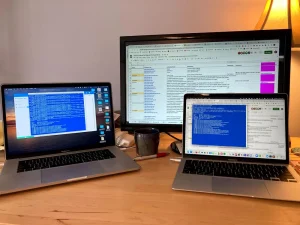
Quinn Dombrowski and 1,300 other volunteers are in a scramble to save Ukraine’s digital culture before the servers and computers that store them are destroyed.
Digital culture includes the images, videos, websites and others stored by libraries, museums, companies and other organizations which represent a country’s social heritage.
The attempt at saving the culture began shortly after the invasion by Russia. On 26th February, Anna Kijas, a librarian at Tufts University tweeted about a data-rescue effort to save Ukrainian websites. This effort was modeled after the 2017 data-rescue event which was planned when there were concerns about what the Trump administration would do to certain websites.
Dombrowski, Academic Technology specialist at Stanford University, reached out to Kijas on Twitter, alongside Sebastian Majstorovic, IT consultant at the Austrian Centre for Digital Humanities and Cultural Heritage who had offered his services to Kijas.
The trio met on Zoom a few days later with some others who were interested in supporting Ukraine with cloud storage and technical assistance. By Tuesday’s end, the approach had been planned, tutorials developed, website built and SUCHO (Saving Ukrainian Heritage Online) was launched the next day. A day later, they had over 400 volunteers. A week later, the volunteers exceeded 1,000.
Currently, SUCHO has over 1,300 active volunteers with more on a waiting list. With no official institutional sponsor, Dombrowski stated that Stanford was supportive with SUCHO with essentially hijacking her day job.
The Association for Computers and the Humanities (ACH), the European Association of Digital Humanities, and the Europeana gave the organization grants to support the effort and cover the costs of things like servers. There’s now a fundraising effort for a part-time support engineer to assist volunteers in troubleshooting the open-source equipment they are using.
SUCHO has saved over 10 terabytes of data, including over 3,000 websites and 15,000 PDFs and images.
The volunteers found their target content in the conspicuous places such as libraries and museums, but they have also been searching the ‘back alleys’ of the internet by using Google Maps to look for storefronts of cultural organizations which may have stored digital information.
‘There’s a beautiful site from the city of Sumy that has after-school and weekend programs that teach children about nature, the Ukrainian language, and Ukrainian identity,’ says Dombrowski. ‘There’s a museum in Novgorod-Siversky dedicated to an epic medieval poem called “The Song of Igor’s Campaign”. This one spoke to me personally— I had studied this poem in grad school. It isn’t an organization with the most resources, but it had pictures, and you could see the events they had held.’
After identification, SUCHO volunteers save the resources in various ways. Sometimes, they include them in a list of relevant URLs submitted to the Wayback Machine, the website recording effort since 1996 by the nonprofit Internet Archive.
Volunteers are also using the open-source archiving equipment from Webrecorder with their storage systems. Recently, they started using Webrecorder’s cloud utility, which allows a website to be archived by simply filling out of a form. This process is incredibly simple even for kids so much that Dombrowski organized an event at her local elementary school to encourage more families to participate.
Time however seems to be the biggest challenge for the group.
‘We’ve seen sites go down shortly after we finished archiving them, and sites that we’ve missed. It’s a race against time’, she said. To get ahead of the curve, SUCHO volunteers are actively monitoring the current situation and focusing on areas where servers are at most risk.
By Marvellous Iwendi.
Source: IEEE Spectrum